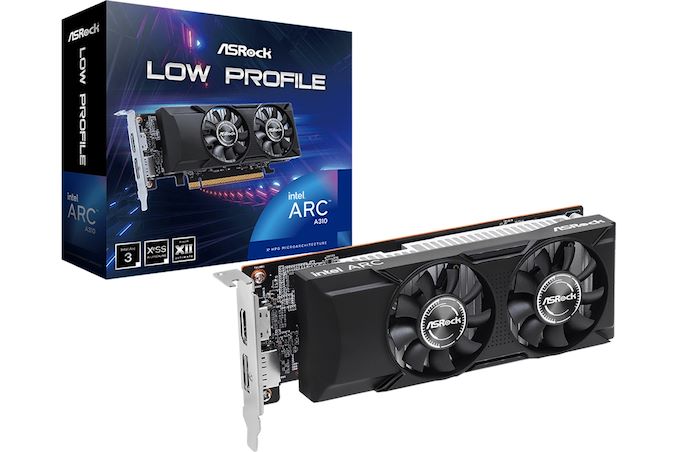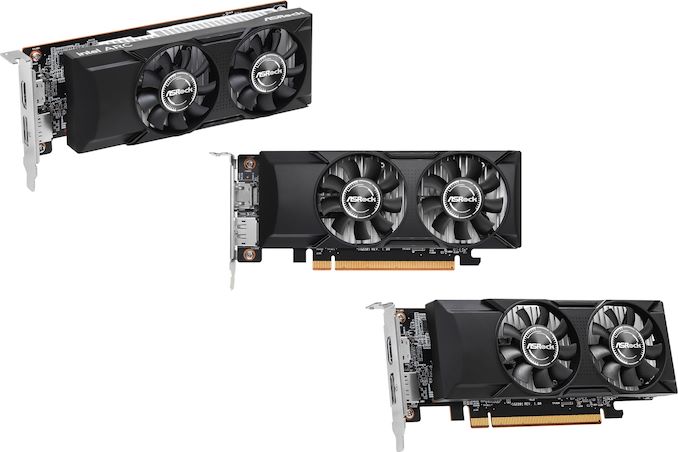ASRock's Low-Profile Arc A310 Fits Every PC and Every Budget
by Anton Shilov on September 14, 2023 6:30 PM EST
ASRock this week has introduced an Intel Arc-based A310 Low Profile 4 GB graphics card. Aimed at the lower power/size/cost portion of the video card market, the entry-level A310 card carries a cut-down ACM-G11 GPU with 768 stream processors operating at 2.0 GHz and a 64-bit memory interface that connects 4 GB of GDDR6. And while its performance isn't anything to write home about, it fills out ASRock's lineup with a budget video card that can also easily be placed into low profile systems.
Performance vise, ASRock's Arc A310 Low Profile graphics card should be comparable to higher-end integrated graphics solutions - which is to say that it's more for general desktop work than demanding games. Notably, as a current-generation Arc card, it incorporates Intel's feature-packed media playback engine, with hardware encoding and decoding for the majority of popular formats, such as AV1, H.264, H.265, and VP9, which makes it a good solution for home theater PCs (HTPCs) as well as office PCs.
The low-profile card offers two display outputs, a DisplayPort (2.0) and an HDMI port (2.0b). In terms of power consumption, this is a sub-75W card (ASRock doesn't give a more precise figure than that), so you won't find any external power connectors as it's entirely bus-powered. Meanwhile, it looks like ASRock has opted to recycle the same dual-slot dual-fan cooling system they use for their other low-profile Arc card, the low-profile ASRock Arc A380.
Wrapping things up, ASRock has not listed a price for the card. Though judging from the cost of other Arc A310 cards on the market, it's likely to end up hitting shelves in the low $100 range.
Source: ASRock











15 Comments
View All Comments
PeachNCream - Thursday, September 14, 2023 - link
Has Intel mentioned anything about the long term future for driver updates and support for Arc? It seems like these things are more or less abandoned by the company since they've been out long enough that it's reasonable to have expected Intel to release a follow-up generational improvement of their dGPUs based on when Arc first hit the market. It notably doesn't seem as though that's the case so this critter looks a lot like a single generation technological dead end which is unfortunate since the other two companies are focused quite heavily on huge, hot, power-hungry designs.Samus - Thursday, September 14, 2023 - link
Not at all abandoned. Driver updates every few weeks for nearly the entire year. The last one added Starfield support and fixed numerous bugs. The irony is Starfield has less issues on Intel ARC than on AMD Radeon (where the sun still has a glitch in the non-beta drivers) so Intel is doing well. I still have issues on my A770 in Battlefield with freesync (basically makes tearing worse) so I have it set to 100hz and VSYNC on, or a 100FPS cap, the card handles this fine at 1080p on my i7-12700k. But Battlefield was really built with RTX cards in mind - AMD cards seem artificially nerfed in BF2042 compared to other games. Such is the industry.Kevin G - Monday, September 18, 2023 - link
When Starfield hit, Intel's ARC wasn't able to launch the game. While there are some bugs on the AMD side at launch, they were less significant than what Intel's were.Jorgp2 - Friday, September 15, 2023 - link
They're still providing updates to their Gen 9.5 GPUs, at least periodically.Intel has much better software support than AMD.
NextGen_Gamer - Friday, September 15, 2023 - link
Yeah, I have no idea why someone would have the impression that Intel abandoned Arc. They have released as many "good" driver updates this year as either NVIDIA or AMD, if not more. By good, I mean ones that not only have usual bug fixes and new game profiles, but also have 10-40% performance improvements in titles or even whole ranges of APIs. I'm keeping my fingers crossed that Battlemage will be even more competitive with AMD and NVIDIA, because when there is good alternatives to them, everyone wins :)Kevin G - Monday, September 18, 2023 - link
Intel finally got into a good pace and quality of releases. If driver support was like it is today at ARC's launch, the impression of that hardware would be radically different. I would argue that Intel is still behind both AMD and nVidia here but not embarrassingly so like it was at launch.The real boon for Intel is that the A750 and A770 are occupying a space that both AMD and nVidia are currently avoiding. Both of those companies want the baseline price for graphics cards to increase. Intel can sweep in and take market share as long as AMD and nVidia are ignoring demand for lower priced cards.
PeachNCream - Tuesday, September 19, 2023 - link
Well actually, that was my mistake. Arc's been talked about for what felt like a long-ish time, but it looks as though last summer was when the first desktop GPUs were released so it's certainly not unreasonable in Intel's known release schedule for an early 2024 launch if they intend to release a new generation. At the moment, I'm still concerned, but if a new iteration is released before next summer, that would be reassuring.meacupla - Thursday, September 14, 2023 - link
If it's like any of the other A310, it should be around 50WSamus - Friday, September 15, 2023 - link
I have an A380 in my BlueIris NVR, it supports CodeProject.AI great. I tried it with DeepStack at the beginning of the year when I first got the card and it was basically unsupported (and DeepStack is being shelved it seems) so seeing CodeProject.AI support it is fantastic news considering its power budget and price compared to...everything else.The best thing nobody seems to talk about with ARC is its headless operation is very good. Intel seems to have considered it as a dual-purpose product from the beginning and it's idle consumption when running as a non-primary "display" controller is fantastic - <10w.
But the primary reason to consider ARC for DVR\NVR is just what is mentioned in this article: encoding\decoding. And it has another advantage no other GPU's offer, a feature only ever offered in Intel CPU's: QuickSync. And its crazy. I tested the A380 with BlueIris before I switched it's purpose to CodeProject.AI analysis and it could encode 10 (the most cameras I have available) at 8MP (~4K) 15FPS video streams in H265 and it was only at 60% load peak, usually around 40%, really depended on motion. But the CPU utilization (my DVR is a Intel i7-8700) was like 5% and the GPU was not used at all - QuickSync was entirely run through the GPU. What's amazing about this is the power consumption was around half of what it was to run the equivalent load on the CPU alone, not to mention the GPU is cheaper than a CPU for this purpose. You could throw an A380 in a cheap Pentium Gold PC and run BlueIris to encode nearly 20 4K primary H265 IP Camera streams using under 100w of power, assuming you aren't using any AI analysis.
ZoZo - Friday, September 15, 2023 - link
I'm assuming that it comes with a normal profile bracket?Also, how is it not passively cooled? Matrox has a passively cooled one.